|
Hubbler Place
Clambercrown
Upper Hardres Road
Bossingham
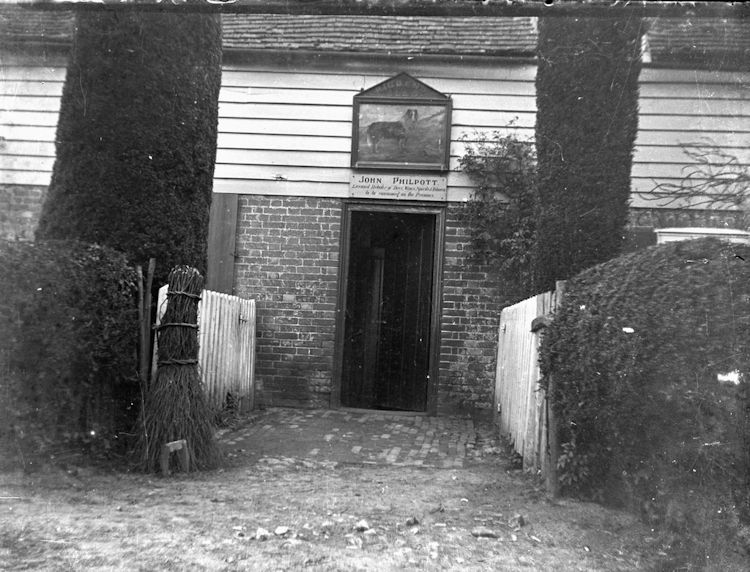
Above photo, date unknown. |
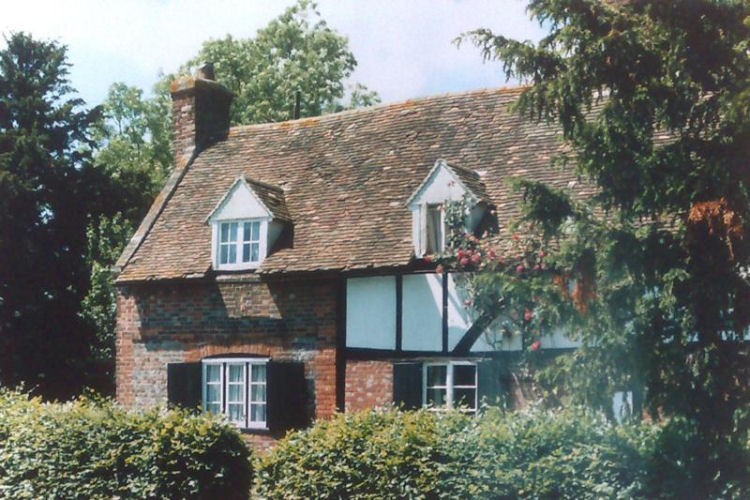
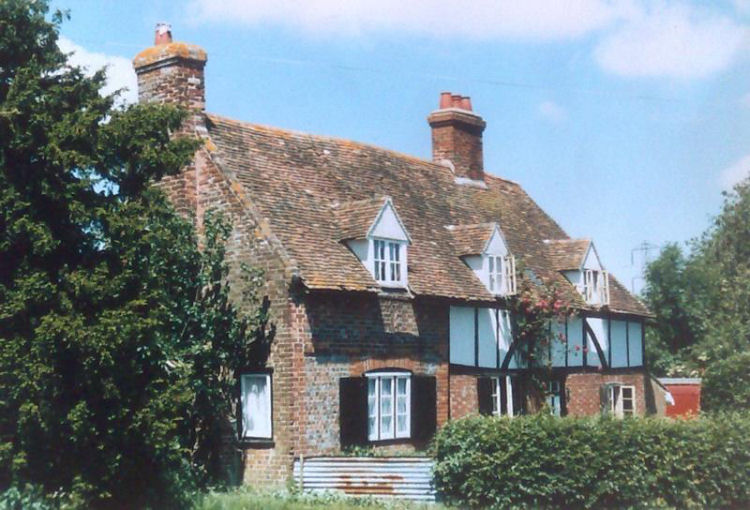
Both photos above showing the former "Dog" at Clambercrown near
Kingston. Photos by Peter Burness. |
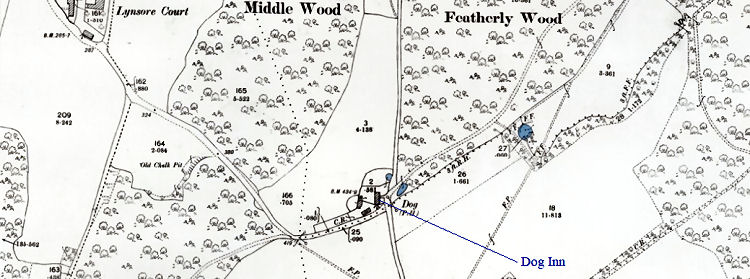
Above map 1896. |
Reference found in the Wingham Division Ale Licence list,
which shows the "Dog," Kingstone (spelt with an extra "e"), to be re-licensed for the sum of 8 shillings in
1740 indicating that the pub was present before 1740.
The Kely's Directory of 1903 gave this as being at Kingston, Canterbury.
Margaret Smith tells me that this is indeed true but the powers that be moved
the parish boundaries again around the 1990s.
The Swing riots of 1830, set off from an impoverished state of farm workers and
the introduction of machinery that were killing their livelihood by putting them
out of work; one machine doing the work of many labourers. Starting in the South
East, the Swing Rioters smashed the threshing machines and threatened farmers
who had them. The name Swing being associated with the signature of a Captain
Swing whose signature appeared on such threatening letters. Local Elham
historian Derek Boughton writes the following:-
One of Francis Castle's sons, who lived at Bossingham,
reported after ten o'clock that there were 7 or 8 men coming from Stelling
Minnis. Dodd mounted his horse and rode to his nearest magistrate, John Bell at
Bourne Park, who authorised him to go to the barracks in Canterbury and get
military assistance.
John Fairman, who worked for Dodd, also lived at
Bossingham. He says “about 11 at night about 20 or 30 passed with great noise of
whistling singing and hallooing.
In the meantime, as predicted the Elham and Bladbean
men had met up at the "Dog" at Clambercrown, which is in a very remote spot just
beyond Palmstead, and some time after 11 the whole party got to Hardres Court,
where they pulled the two machines, which were hired from John Holman of
Canterbury and Thomas Harnett of Newington next Sittingbourne, out of the barn
and smashed them.
John Fairman continues: “At Hardres Court, there was
knocking as of breaking iron for half an hour, three loud cheers, then they
dispersed, the greater part towards Elham, some to Stelling Minnis passed my
house.
John Whitnall, waggoner to Mr Dodd, confirms that the
parties separated at Hardres Rectory, and he recalls three things he heard them
say: “The great wheel has broke our hammers”, “Remember Monday night”, and “You
Stellingers go that way, and the Elhamers this”.
The Elhamers in fact went back via the "Dog", where
they got the landlord up and had three or four gallons of beer. It was paid for,
but there appears to be some mystery as to who actually did so.
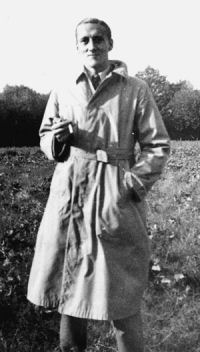 Further research suggests this may be the same public house as described by
Jocelyn Brooke (picture left) in the book "Dog at Clambercrown." The book is a
semi-autobiographical novel following the pattern of Brooke's previous work "The
Orchid Trilogy" but reveals a more homoerotic nature. The book uses the pub at Clambercrown as a metaphor for the unattainability of adulthood from a child's
perspective. Further research suggests this may be the same public house as described by
Jocelyn Brooke (picture left) in the book "Dog at Clambercrown." The book is a
semi-autobiographical novel following the pattern of Brooke's previous work "The
Orchid Trilogy" but reveals a more homoerotic nature. The book uses the pub at Clambercrown as a metaphor for the unattainability of adulthood from a child's
perspective.

|
From RAMBLES AROUND FOLKESTONE BY "FELIX."
"CLAMBERCROWN" AND "THE DOG."
Take a large scale map of Kent, and you will find
what great patches of woodland are marked to the north
of Elham. In addition to North Elham Park, Clever Tie,
there are West Wood, Elham Park, and the Great
Covet Wood, which alone spreads itself over 1,000 acres. These great woodlands are practically joined together, and
one can walk for hours through scenes which suggest "a
thousand miles from any where." On Sunday my route
was entirely off the main roads. Solitude! Here it is.
But yet no solitude. There is an endless feast of delight for the
observer. It is indeed good to have the companionship of Nature for a few hours away from the stress and
battle of life. On the "Clambercrown" I saunter easily
along. The farm houses are few and far between. A
human being is a rarity. Look! There are two or three
fluttering objects! What are they? Specimens of the
lovely clouded yellow butterfly. In the sunshine their
colours show grandly against the deep green foliage. Only a momentary glance, yet one to be remembered. But
I make no secret about it I want "The Dog." After a
considerable spell of more quiet walking, I arrived in front
of another farm building. Some of the hands were resting
over the gate. I enquired "Where's 'The Dog'?" In
chorus they directed me up a narrow lane, and added:
"When you come to a signpost take to the road leading
to Lower Hardres; then you will find 'The Dog' on the left-hand side." And sure enough, on the confines of "The
Covet" was a small inn. Where is the custom, you will
ask, to maintain it I entered, and felt entitled to ask
for refreshment. As the saying goes, "I could do with
it." Through its very solitude, "The Dog" is famous. It
is owned by a pair of "originals" a middle-aged brother
and sister of the name of Philpott. Both unmarried, they
have lived their lives here, amidst these surroundings, as
their parents did before them. |
|
From the Kentish Gazette, 12 July 1842.
EAST KENT.
Ospringec, Faversham, Canterbury, Blean, Harbledown, Whitstable,
Kingston, Bishopsbourne, Hardres, Chartham, and Snave, in Romney Marsh.
MR. JOHN POUT Begs to announce that he has received instructions to
offer by PUBLIC AUCTION, AT the "Royal Fountain Hotel," CANTERBURY, on
MONDAY, the 29th, and TUESDAY the 30th days of AUGUST next, at Eleven
o'clock each day (unless the same, or any part thereof, shall be
previously disposed of by Private Contract, of which due notice will be
given), the following lots of very desirable FREEHOLD PROPERTY, viz:—
Lot 46.— A PUBLIC HOUSE, called the Dog, with the garden and pasture
LAND, containing 8a. 2r. 35p., more or less, situate in GREAT HARDRES
and KINGSTONE aforesaid, or one of them, in the occupation of Mr.
Holtuin and Mr. Philpot.
|
|
From the Folkestone Herald, 2 January, 1926.
ABOUT THE NEIGHBOURHOOD By Felix
The “Dog” is No More.
In order to stretch the limbs and walk of the extra fare at Christmas a
party of half a dozen young citizens took train to Elham on Boxing Day,
their real objective being the lonely and isolated inn known as the
“Dog” at Chambercrown. Out of all the thousands in Folkestone how many
have tramped, as I have often done, across a part of Rhodes Minnis,
through Wheelbarrow Town (about a dozen houses0 and on through densely
wooded country to Clambercrown. As I wrote once in my “Rambles,” one
could imagine themselves out here in the centre of Africa, so far as
loneliness is concerned. The “Dog” stood on the borders of the great
Covet Wood, and the license was jointly held by Miss Philpott, widely
known over the countryside as “Lizzie” and her brother John. They were
what might be described as a couple of “characters.” They belonged, it
would almost seem, to a past age. One lived, as it were, a hundred years
ago in that old place. There was a great open fireplace with lintel, a
chimney corner on either side. Coal was almost an unknown quantity up
yonder. On the hearth generally smouldering a big log. From the chimney
hung a chain with a big hook at the end. From this was usually hanging
an immense iron pot. There was no bar in the accepted sense of the word.
Customers were accommodated in a kind high-backed pew, whilst the
necessary beverages were served from behind a screen. I had the pleasure
of conducting several little parties up yonder, amongst that my departed
friend, the late Mr. Andrew Bromley, who sketched the fire place.
The Jersey had “Run Dry.”
I cannot resist a smile even now when I recall how one Saturday
afternoon a little party of us had tea at the “Dog.” Mr. Bromley was one
of that party. It was left to my humble self to ask dear old Lizzy if
she could provide us with tea. She consented. After some delay the tea
was placed on the table. Where, however was the milk? On enquiry we were
informed that the Jersey cow (which grazed in an adjoining meadow) had
“run dry!” There was no milk in the house, and no neighbouring farm
where we could secure a supply. We consented then to partake of the
beverage without milk. We desired an egg each, but back came the
information that there were only three in the nests. As a result we had
to toss, the odd man standing out. We “enjoyed,” too, spread on slices
of bread, what is known as “crock” butter. This was of a varied colour –
a queer mixture. However, we pulled through somehow, and really enjoyed
the fun. I know of a certain Councillor and his wife who tramped across
to the famous “Dog” on a certain Bank Holiday. Their intention was to
partake of lunch at the old inn. They experienced a shock. When the
aforesaid Councillor asked for “lunch for two” the good old landlady
replied that they did not do that kind of thing up at Clambercrown. As
there was no other form of food available in the house, it was a case of
tramping on in a semi-exhausted state to Bishopsbourne. I was stranded
up that way in a similar manner some years ago. I tramped over from
Barham, across “Heart's Delight,” and then up through the mazes of the
Covet Wood. I had forgotten to take any sandwiches, or other form of
food. I asked one of the joint proprietors if they had any bread and
cheese. The old lady replied slowly, “yes,” but added “Not for sale.” I
don't mind admitting that at the time I felt what is known as a bit
faint. There were two haymakers sitting in the “pew” before referred to.
One of these eyed me up and down several times and at length remarked:
“I ‘eered you ask for a bit o' bread and cheese.” He then dived into the
recesses of a rush basket and brought out what might be termed a good
hunk of bread and cheese and what is known in the rural districts as a
“thumb piece.” This Christian gentleman (and so he was) remarked: “Take
yer choice. Yer welcome.” This was pretty good, thought I, for a
stranger, I accepted the “thumb piece.” This was a nice slice of
home-made bread, on the top of which was a layer or two of nicely
pickled pork. Well, I showed my gratitude to the farmer-hand friend in
some other form than words. I have attended many a banquet at the
principle hotels in Folkestone and other places since that now distant
date, but never have I enjoyed anything with more real rest than I did
that “thumb” piece from the old rush basket.
Only a Memory.
I had heard from several sources that of late the old inn, owing to lack
of custom, had closed its doors for good. Since the Philpott's
relinquished it, others have “tried their hand” at the place, but to no
purpose. The “Dog” has “gone to the dogs” through lack of trade. No one
can quite understand how a living was ever made up there. There are a
few who, as I have said, penetrated through “the unknown” to the old
place, but there are thousands (and some of then that pride themselves
on a knowledge of the countryside) who never did reach that “promised
land.” I am sorry my young friends on Boxing Day had a lost journey in a
certain sense, but I am glad to have the means of introducing them to as
glorious a stretch of country as is to be found around those parts. The
roads are better now, and thus there has been less difficulty in
reaching Clambercrown, but at the time I am referring to the narrow
highways were covered with jagged field flints. Thus another old and
quaint institution has vanished. Around that country, including Lower
Hardres, I have spent some of the best times of my life. |
LICENSEE LIST
QUESTED Henry 1740+

PHILPOTT John 1840-41+ (age 77 in 1841 ) )
PHILPOTT Stephen 1847-84+
   (also
blacksmith age 56 in 1861 (also
blacksmith age 56 in 1861 ) )
PHILPOTT John 1891-1913+ (age 43 in 1891 ) )
  
PHILPOTT Elisa to June/1921

GRAY James June/1921+

https://pubwiki.co.uk/Dog.shtml
http://www.closedpubs.co.uk/dog.html
 From Wingham Division Ale Licences 1740 Ref: KAO - QRLV 3/1 From Wingham Division Ale Licences 1740 Ref: KAO - QRLV 3/1
 From
Bagshaw Directory 1847 From
Bagshaw Directory 1847
 From Melville's Directory 1858 From Melville's Directory 1858
 From the Post Office Directory 1882 From the Post Office Directory 1882
 From
the Kelly's Directory 1899 From
the Kelly's Directory 1899
 From the Kelly's Directory 1903 From the Kelly's Directory 1903
 From the Post Office Directory 1913 From the Post Office Directory 1913
 From the Dover Express From the Dover Express
 Census Census
|





 Further research suggests this may be the same public house as described by
Jocelyn Brooke (picture left) in the book "Dog at Clambercrown." The book is a
semi-autobiographical novel following the pattern of Brooke's previous work "The
Orchid Trilogy" but reveals a more homoerotic nature. The book uses the pub at Clambercrown as a metaphor for the unattainability of adulthood from a child's
perspective.
Further research suggests this may be the same public house as described by
Jocelyn Brooke (picture left) in the book "Dog at Clambercrown." The book is a
semi-autobiographical novel following the pattern of Brooke's previous work "The
Orchid Trilogy" but reveals a more homoerotic nature. The book uses the pub at Clambercrown as a metaphor for the unattainability of adulthood from a child's
perspective.